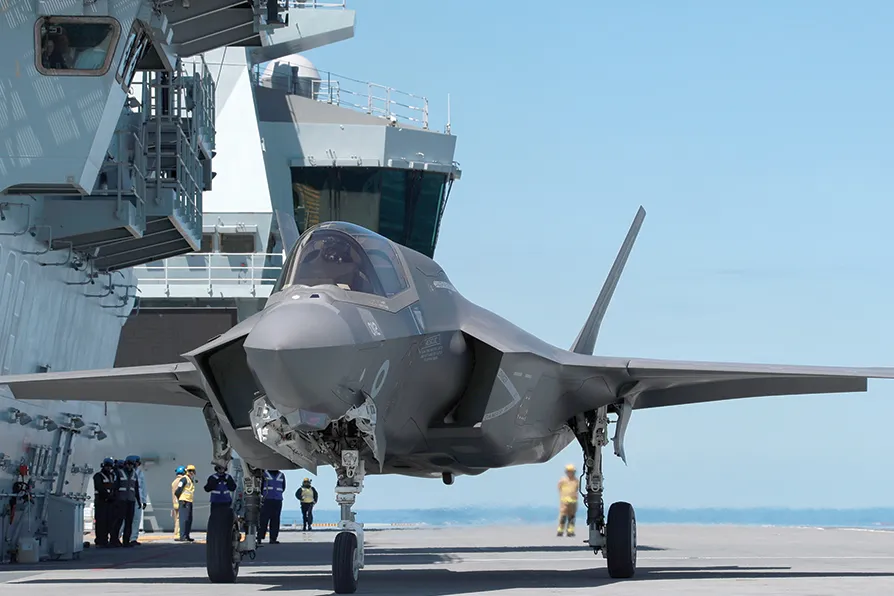SOLOMON HUGHES examines the shift in Labour rhetoric on racism and Reform UK – and what’s driving it
A new report says the government’s purchase of US nuclear-armed aircraft prioritises transatlantic politics over military needs and ignored its own Strategic Defence Review, writes LINDA PENTZ GUNTER

 An F-35B Lightning on HMS Queen Elizabeth, in 2020, is not nuclear-capable hence the upgrading to F-35As which are equipped for US B61 nuclear bombs / Pic: LPhot Luke/MOD/CC
An F-35B Lightning on HMS Queen Elizabeth, in 2020, is not nuclear-capable hence the upgrading to F-35As which are equipped for US B61 nuclear bombs / Pic: LPhot Luke/MOD/CC
WHEN the British government announced its intention last June to purchase 12 F-35A nuclear capable Lightning II Joint Strike Fighter aircraft from the US by 2033 and join Nato’s “dual capable aircraft nuclear mission,” it described the decision as the “biggest strengthening of the UK’s nuclear posture in a generation.”
But a new study released on November 11 by two British watchdog groups, Nukewatch UK and Nuclear Information Service, argues that the purchase of the planes will incur massive costs to the British taxpayer while not actually being militarily necessary or advantageous.
The report, “Smoke and Mirrors,” concludes that “the government’s decision is based principally on providing political ‘smoke and mirrors’ to distract attention from questions relating to the US-Europe relationship within Nato rather than developing a must-have military capability.”
The purchase of the F35As “serves more as a diplomatic gesture than a military imperative,” the study said, designed to placate US President Donald Trump’s gripes about a perceived lack of financial commitment from Nato partners.
The UK decision to participate in the Nato nuclear sharing mission “is being driven forward by the nuclear lobby within government itself, and raises questions about whether the decision was driven by strategic necessity or political expediency,” the study authors wrote.
The 12 F-35As are far too few to constitute a credible deterrent, according to experts, in large part because the plane’s track record already indicates that all 12 will rarely be in service at the same time.
“On the basis of current performance, at any one time at best only eight aircraft would be available to take part in a nuclear strike — and possibly even fewer. It is possible that not all of these aircraft would penetrate enemy air defences to reach their targets,” the study said.
The planes are expected to be stationed at RAF Marham in Norfolk. However, as the study noted, this is actually too far away for F35As to reach any meaningful targets inside Russia, for example, as “the maximum distance the aircraft can travel from its base to complete its mission and return without refuelling is 1,000 km,” (about 683 miles).
The F-35A will carry the US B61 nuclear gravity bomb, the only plane in the F-35 class able to do so. The current RAF fleet of F-35Bs and the Eurofighter Typhoon are not nuclear-capable so the purchase “potentially gives the RAF a nuclear strike capability using this weapon” the Smoke and Mirrors report said.
Further, since the B61 is a US bomb, any deployment will remain under full US control, “rendering the operation entirely dependent on American permission,” the study said.
According to Nukewatch UK, those bombs were already delivered in July to RAF Lakenheath in Suffolk — in reality a US Air Force base despite its name. This would mark the first stationing of US nuclear weapons on UK soil since 2008.
Establishing the programme will also be costly, lengthy and complicated and is unlikely to reach fruition for many years, the study said, due to the many complex steps that will need to be taken before the UK can join the Nato nuclear sharing programme.
The extreme expense — at least £60 million per plane plus the costs of parts and maintenance — will be a burden on British taxpayers already suffering from cuts to social services, the report pointed out. “At a time when public services are struggling to meet demands, there is little public appetite for more military spending,” wrote the report’s authors. “An expensive nuclear weapon system that will not be available for nearly a quarter of a century is a low priority, even on the UK military’s wish list – if, indeed, such a capability is even needed.”
The purchase may also burden the UK military by depriving it of other resources, including the next tranche of F-35Bs. An analysis by Navy Lookout, which delivers independent Royal Navy news and analysis, concluded that a shortfall in F-35Bs could be problematic, “as F-35As cannot operate from carriers and contribute nothing to their strike power,” it said.
The Navy Lookout analysis also argued against using RAF Marham for the planes, given the base “will need expensive refurbishment and regeneration” and recommended Lakenheath instead.
The Smoke and Mirrors study endeavors to extract the reality from the opaque government announcement made on June 24 on the eve of the Nato Summit at The Hague. After “stripping away all the verbiage,” the study authors concluded that the statement lacked “even basic information such as when the aircraft are intended to be delivered and when their nuclear capability is intended to be operational.”
Even without delays, the report said, “it will be years, rather than months, before they are available for operation.”
The report also points out that Britain’s own 2025 Strategic Defence Review published on June 2 does not include a recommendation to purchase F-35As equipped for US B61 bombs and instead advises a detailed study on such an option.
“The fact that it’s not there indicates that we weren’t terribly enthusiastic about it,” the SDR’s lead reviewer, Lord Robertson, a former defence secretary and a former secretary-general of Nato, told the report authors.
Despite this, the Starmer cabinet enthusiastically threw its support behind the proposal in what Robertson described as “a decision independent of the review.”
The report authors also point out that “the decision to join the Nato mission appears to have been made before the SDR was even published.”
The timing, the report concludes, “reflects a long-standing trend by the UK government to prioritising transatlantic politics over genuine military needs, providing Starmer with an opportunity to appease Trump and ‘put something on the table’ to smooth the waters at a potentially contentious Nato summit.”
What is actually on that table may be little more than an attempt to “deceive the public and politicians from other Nato countries into thinking that the UK is taking a significant step to strengthen its nuclear forces when in reality it is doing next to nothing,” the authors concluded.
The government’s decision to return US nuclear weapons to the UK and invest in expensive nuclear-capable aircraft should, as in the past, precipitate “worries and debate about their costs, benefits and feasibility,” the study concluded.
It should also provoke continued worries as to why we continue to invest vast sums in a technology that can only ensure our own destruction?
As the report states: “It is difficult to see consistency logic or any need for the UK to purchase F-35A aircraft and join Nato’s nuclear mission from a practical military viewpoint.” There is no logic from a human viewpoint, either.
Linda Pentz Gunter is a writer based in Takoma Park, Maryland.










